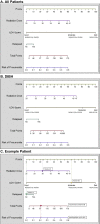Using benchmarked lung radiation dose constraints to predict pneumonitis risk: Developing a nomogram for patients with mediastinal lymphoma
- PMID: 30202805
- PMCID: PMC6128097
- DOI: 10.1016/j.adro.2018.03.005
Using benchmarked lung radiation dose constraints to predict pneumonitis risk: Developing a nomogram for patients with mediastinal lymphoma
Abstract
Purpose: We identified lung dosimetric constraints to assist in predicting the radiation pneumonitis (RP) risk in patients with mediastinal lymphoma and then identified the clinical prognostic factors that were associated with the achievement of key dosimetric constraints.
Methods and materials: In 190 patients who received mediastinal intensity modulated radiation therapy, we used univariate χ2 and multivariate logistic models to identify the predictors of RP and achievement of lung dose-volume histogram (DVH) constraints and build a predictive nomogram for RP.
Results: An increased risk of RP was strongly associated with mean lung dose (MLD) > 13.5 Gy (odds ratio [OR]: 8.13; 95% confidence interval [CI], 3.01-21.93; P < .001) and the percent of lung volume receiving ≥5 Gy (V5) > 55% (OR: 7.01; 95% CI, 2.94-16.72; P < .001). Therefore, patients had low RP risk (8%) if both MLD ≤13.5 and V5 ≤55 constraints were achieved, moderate risk (24%) if only MLD was achieved, and the highest risk (48%) if MLD was not achieved. Deep-inspiration breath-hold (DIBH) technique during treatment strongly prognosticated achieving MLD and V5 DVH constraints (OR,3.88; 95% CI, 1.84-8.19; P < .001). Specifically, 86% of patients who were treated with DIBH versus 63% without DIBH achieved DVH constraints (P < .001). This translated into a "number needed to treat" with DIBH of 4 patients to enable 1 additional patient to achieve both constraints. In comparison, the clinical characteristics were marginal prognosticators: DVH constraints were more likely achieved in nonbulky disease (OR: 3.01; 95% CI, 0.89-4.53; P = .09) and patients who had not previously received salvage chemotherapy (OR, 2.44; 95% CI, 0.98-6.11; P = .06). Nomogram-predicted risks of RP ranged from 4% to 60% on the basis of MLD and V5, total radiation dose, and use of salvage chemotherapy.
Conclusions: Achieving mean lung and V5 DVH constraints is critical to reduce RP risk in patients with lymphoma who receive mediastinal intensity modulated radiation therapy. The use of the DIBH technique is a promising risk-modifying treatment approach in patients with mediastinal lymphoma and especially in patients with a history of nonmodifiable risk factors for RP such as bulky disease and salvage chemotherapy.
Figures



References
-
- Graham M.V., Purdy J.A., Emami B. Clinical dose-volume histogram analysis for pneumonitis after 3D treatment for non-small cell lung cancer (NSCLC) Int J Radiat Oncol Biol Phys. 1999;45:323–329. - PubMed
-
- Cella L., Liuzzi R., D'Avino V. Pulmonary damage in Hodgkin's lymphoma patients treated with sequential chemo-radiotherapy: Predictors of radiation-induced lung injury. Acta Oncol. 2014;53:613–619. - PubMed
Grants and funding
LinkOut - more resources
Full Text Sources
Other Literature Sources

